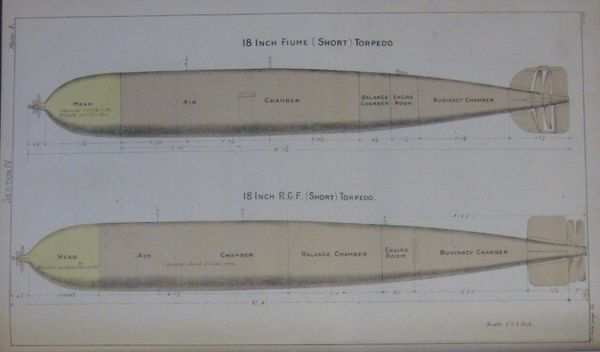18-in Mark I Torpedo (UK)


The 18-in R.G.F. Mark I Torpedo was a British torpedo torpedo manufactured at the Royal Gun Factory from 1892.[3] Before the advent of the Mark II model, it was commonly referred to as the 18-in R.G.F. Torpedo.
Like a slightly earlier Fiume model, it was built in both "long" and "short" versions.
Contents
Development
A single example from the R.G.F. was received at the range in June and was run 400 times to test different propellor designs. The "short" models were to weigh 850 pounds and be 11.5 feet long. The R.G.F. articles proved lighter, at 831 pounds. A second design was 12 feet 4 inches long and 850 pounds, and had a larger engine giving greater stability. As this still worked in the experimental tube, two more of these were ordered.[4]
A long R.G.F. torpedo and long and short 18-in Fiume torpedoes were comparatively evaluated in 1890 alongside proven 14-in designs. Fired from Seagull while she was at 18 knots, the long R.G.F. torpedo deflected 17.5 degrees when fired 57 degrees (firing angle may be misread from a blurry image) abaft the beam, 22.5 degrees when fired 30 degrees abaft, the same 22.5 degrees when fired abeam, and 16 at 30 degrees ahead and 7 degrees at 60 degrees ahead. The short torpedo generally did a little better except at the last angle: 21, 17, 17, 6 and 7 degrees. When these deflections were allowed for, the long Fiume would have been lost on 4/23 shots, and the short Fiume on 5/14 versus just 2/20 for a long R.G.F. model.[5]
Mark I*
Manufacture and use
1891
The second order of 100 long torpedoes at Woolwich was placed in 1891-92, and a further 96 were ordered in 1892-93.
Short torpedo orders amounted to 48 in 1891-92, and the first five completed weapons did 28.2 knots over 600 yards in 51 degree water.[6]
The first order of 85 long torpedoes from the R.G.F. was completed in 1892. After adjustment at the Horsea range, the 55 fitted for A.W. fire averaged 30.73 knots over 600 yards in 58 degree water, taking 18 runs to pass each on average. Average speed to 800 yards was estimated to be about a knot less, but the Horsea range only permitted 60 yard runs.[7]
The torpedoes set for submerged fire averaged 28.53 knots in 54 degree water, taking 16 runs to pass the average specimen.[8]
1896
Horsea adjusted a number of these in 1896:[9]
- two short torpedoes averaged 27.63 knots at 600 yards in 63 degree water.
- eight with Side Lugs averaged 29.15 knots to 600 yards in 42.4 degree water.
- seven with Hook Brackets averaged 28.02 knots to 600 yards in 52.1 degree water.
- three short torpedoes under repair made 27.87 knots at 600 yards in 46.7 degree water.
1905
In 60 degree water, 18-in H.B. torpedoes of Mark I* through IV were approved for the setting of 1,500 yards at 20.25 +/- 0.25 knots at 1,400 pounds pressure. The S.L.L.R. torpedoes of the same Marks did at 21.75 knots to 1,500 yards and the S.L.S.R. models 25.25 knots at 1,350 pounds pressure.[10]
1918
26 of 86 remaining Mark I/Mark I* torpedoes were broken up in 1918.[11]
1919
In 1919, it was approved to break up all 18-in R.G.F. torpedoes Mark I* to Mark III.[12]
Footnotes
- ↑ Annual Report of the Torpedo School, 1890. Plate 1.
- ↑ Annual Report of the Torpedo School, 1891. Plate 5.
- ↑ Annual Report of the Torpedo School, 1892. p. 26.
- ↑ Annual Report of the Torpedo School, 1890. pp. 22-4.
- ↑ Annual Report of the Torpedo School, 1890. p. 32.
- ↑ Annual Report of the Torpedo School, 1892. p. 27.
- ↑ Annual Report of the Torpedo School, 1892. pp. 26-7.
- ↑ Annual Report of the Torpedo School, 1892. p. 27.
- ↑ Annual Report of the Torpedo School, 1896. pp. 42, 43.
- ↑ Principal Questions Dealt with by the Director of Naval Ordnance, 1905. pp. 440, 441.
- ↑ Annual Report of the Torpedo School, 1918. p. 10. (G. 8472/18).
- ↑ Annual Report of the Torpedo School, 1919. p. 11.
Bibliography